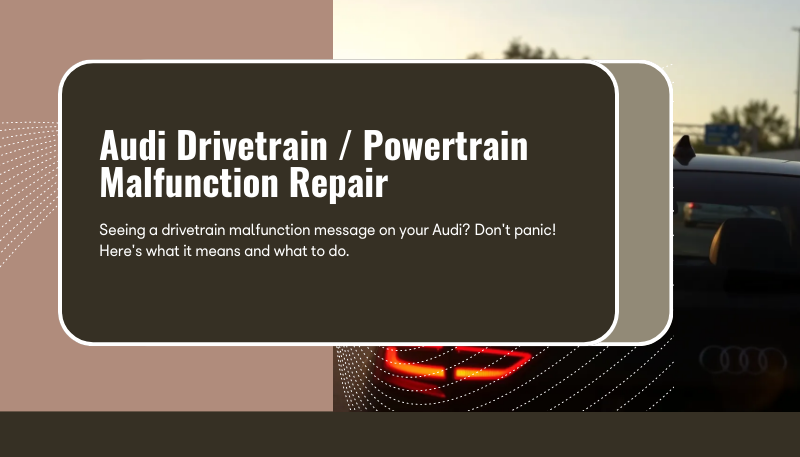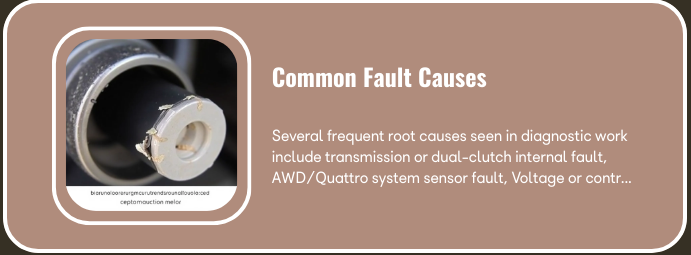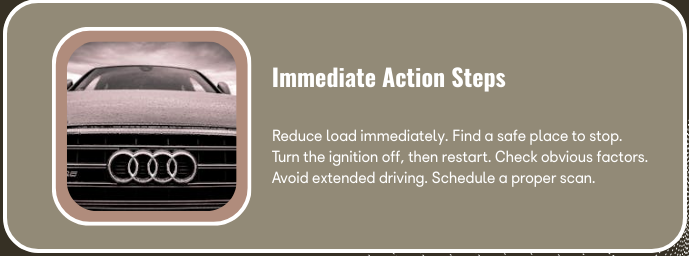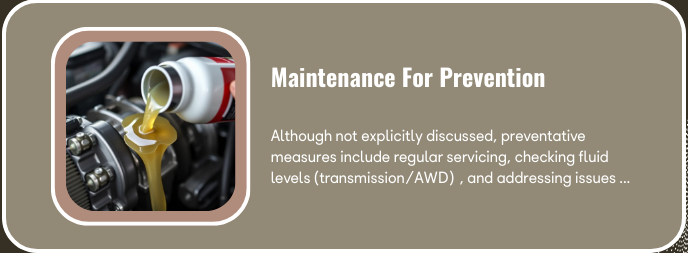When your Audi displays a message like “Drivetrain Malfunction” or “Drive System Malfunction”, the issue is immediate and serious. It may indicate a fault in propulsion, transmission, all-wheel-drive (AWD) systems, or sensors—anything that sits between the engine and the road. For Audi owners in the Dallas/Plano region, speedy, expert care is essential. You need more than a quick scan—you need precision diagnosis, access to correct parts, and a clear plan to restore performance and reliability.
At our facility in Plano, we serve the Dallas metropolitan area with a depth of Audi-specific experience that far exceeds general repair shops. Below, we explain what the warning means, typical causes, how we diagnose and repair it, and why choosing a specialist matters.
What Does “Drivetrain / Powertrain Malfunction” Actually Mean?
Quick summary: This warning is a broad alert that your Audi’s system controlling engine power delivery, transmission/shifting or AWD system is out of spec. It doesn’t pinpoint the component—it signals the system as a whole is under duress.
A vehicle may still run—but often in a reduced-power mode—or it may shut down. On forums, Audi owners report their cars “cutting out” or refusing to start after such messages.
Internally, possible offenders include:
- The transmission or dual-clutch gearbox (for example S Tronic) failing to shift correctly or maintaining pressure
- AWD (Quattro) system sensors or actuator faults causing power distribution errors
- Engine torque management sensors or modules detecting an anomaly and entering limp mode
- Voltage or control-module issues that disrupt the powertrain control logic
The key takeaway: Don’t ignore it. Delay increases risk of collateral damage—particularly costly on high-performance Audi models where drivetrain components are engineered to tight tolerances.
Why Dallas/Plano Driving Conditions Make This Worse
Texas heat, stop-and-go traffic, and urban driving stress luxury powertrains in a way that typical driving may not.
- High ambient temperatures raise transmission and AWD system thermal loads.
- Frequent changes in speed (Dallas interstates, Plano traffic) demand more from automatic and dual-clutch systems.
- Luxury AWD systems (as in many Audis) require correct fluid levels and system calibration—if neglected, faults crop up sooner.
Because of these conditions, Audi drivetrain or powertrain faults manifest faster here than in moderate climate zones.
Common Causes of Drivetrain / Powertrain Malfunctions in Audis
Here are several frequent root causes seen in diagnostic work, along with what they mean for the repair path.
Diagnostics Process: How to Pinpoint the Fault
- Road test with symptom capture. We drive the vehicle to replicate the fault and understand how the failure presents itself (shifts, AWD slip, limp mode).
- Full-system scan using Audi-specific diagnostic tools. This goes beyond a generic OBD reader—it accesses transmission, AWD, engine, and control modules.
- Physical inspection. We check fluid levels (transmission/AWD), wiring harnesses, battery/voltage, mechanical linkages.
- Fault code review & data-logging. We interpret the data logged—what torque was requested vs actual, sensor deviations, temperature or pressure anomalies.
- Recommendation & transparent estimate. We present the findings, explain possible repair paths (e.g., component replacement, fluid/actuator service, sensor or wiring fault). You decide the scope.
- Repair with OEM or equivalent high-quality parts. Repairs are done following Audi’s factory procedures. We use authentic or equivalent quality components and reset adaptives as needed.
- Final road-test & verification. The job is only done when performance is restored, fault codes cleared, and the vehicle returns to optimal operation.
Quick Definition: Drivetrain vs. Powertrain (Answer-First)
Drivetrain is the set of components that transfer power from the transmission to the wheels (driveshafts/axles, differentials, Quattro/Haldex components). Powertrain includes the drivetrain plus the engine and transmission. A “drivetrain/powertrain malfunction” warning means a control module has detected conditions outside of normal parameters within these systems and has limited performance to protect components.
What To Do When Your Audi Shows “Drive System/Drivetrain Malfunction”
- Reduce load immediately. Ease off the throttle and avoid hard acceleration or towing.
- Find a safe place to stop. If the warning persists or the car enters reduced-power (limp) mode, pull over safely.
- Turn the ignition off for a minute, then restart. A temporary restart may clear transient electrical or sensor glitches—but treat this as diagnostic information, not a fix.
- Check obvious factors. Low battery voltage, recent jump-starts, or electrical work can induce drivetrain faults. If safe, verify no burning smells, leaks, or severe vibrations.
- Avoid extended driving. Continued operation can escalate wear or heat-related damage in S-tronic/Tiptronic transmissions or Quattro components.
- Schedule a proper scan. Book an Audi-specialist diagnostic to read transmission, engine, and AWD module codes—not just generic OBD. We service Dallas and Plano with Audi-specific tools and procedures.
“Is It Safe To Keep Driving?”
Short answer: Only to exit traffic or reach a safe location. If the car is in limp mode, continuing to drive can overheat or starve critical components, turning a sensor-level fault into a mechanical repair. When in doubt, arrange a diagnostic visit or towing to prevent collateral damage.
Mini-Checklist: Signs Your Audi Needs Immediate Attention
- Red warning light or audible chime paired with drivetrain/powertrain message
- Car won’t shift beyond certain gears; “surging” or slipping on take-off
- Burning smell, smoke, or sudden increase in transmission temps
- Loud clunks from the center/rear under load or on tight turns
- Repeated warning after a restart or shortly after it clears on its own
Can You “Reset” the Warning Yourself?
A battery pull or code clear can remove the message temporarily, but the control modules will re-assert the fault once conditions recur. Modern Audis log detailed freeze-frame data; the right path is to read that data, confirm the subsystem (engine, transmission, AWD), and fix cause—not just clear codes.
Common Audi Issues—and What They Feel Like
- S-tronic/dual-clutch mechatronics fault: Harsh shifts, gear hunting, “PRNDS” flashing, limp-mode behavior.
- Quattro/Haldex pump or sensor issue: Unusual binding in tight turns, traction-control lights, front-only feel on acceleration.
- Turbo/boost-control error (wastegate/actuator): Reduced power, under-boost fault code, sudden “drive system” message under load.
- Voltage irregularities/battery weakness: Multiple system warnings, intermittent drivetrain faults after cold starts or short trips.
- Wheel-speed/torque/position sensors out of range: ABS/ESC lights combined with drivetrain warnings; possible false triggers after wheel/tire changes.
- Combustion/ignition anomalies (coils, plugs, injectors): Misfires under load, rough idle, and powertrain fault logic limiting torque.
Why Choose a Specialist Over a General Repair Shop
Audi engineering demands a higher level of specialization. A generic repair shop might scan and replace the obvious but often misses root causes—leading to recurring faults and higher cost. Key advantages of a specialist:
- Access to Audi-specific diagnostics and training.
- Familiarity with AWD (Quattro) and dual-clutch/Tiptronic systems unique to Audi.
- Experience diagnosing subtle interactions between powertrain, transmission and AWD modules.
- Proven warranty-backed work. At our Plano location we provide a 3-year / 36,000-mile warranty on labour.
- Focused service for Audis—not general fleets—meaning faster turnaround and fewer surprises.
What It Means From a Driver & Business Perspective
For Drivers: Early detection saves significant cost. A transmission failure or AWD system collapse can easily run into the thousands. A precise diagnosis means you understand exactly what’s wrong and budget accordingly rather than throw parts at the problem.
For Professionals & Business Owners: If your Audi is a tool for your work (driving clients, representing your brand, etc.), downtime equals lost productivity or revenue. Serving the Dallas/Plano market, we offer efficient turnaround, clear estimates, and minimised downtime—so you stay mobile.
Maintenance Moves That Prevent Recurrence
- Keep the 12V system healthy. Modern torque and shift strategies are voltage-sensitive; test the battery and charging system annually and after extreme heat.
- Follow correct fluid intervals. S-tronic/Tiptronic and Haldex/Quattro fluids shear with heat; staying on interval prevents pressure and clutch issues.
- Use Audi-approved tires and sizes. Mismatched rolling diameters stress AWD clutches and can trigger drivetrain logic faults.
- Mind heat cycles. Dallas summers are hard on transmissions; avoid repeated hard launches when temps are high.
- Scan after wheel/tire or suspension work. Calibrate systems if required so wheel-speed and torque calculations stay accurate.
FAQs – Quick Answers
Q: Can I still drive if I see the drivetrain warning?
A: Possibly, but you’re in limp mode and risk further damage. It’s best to stop soon and have it inspected.
Q: What’s the typical cost?
A: It depends heavily on cause. A sensor change or fluid service is less expensive than a full transmission or AWD system replacement. We provide transparent estimates after diagnostics.
Q: Will dealer service be better?
A: Dealers have factory parts and systems, but often come with higher price and wait times. A specialist gives equivalent diagnostic ability with faster service at better value.
Q: How long will repairs take?
A: Simple sensor or fluid services might be same-day. More complex powertrain/transmission work might require parts and take 1-3 days.




